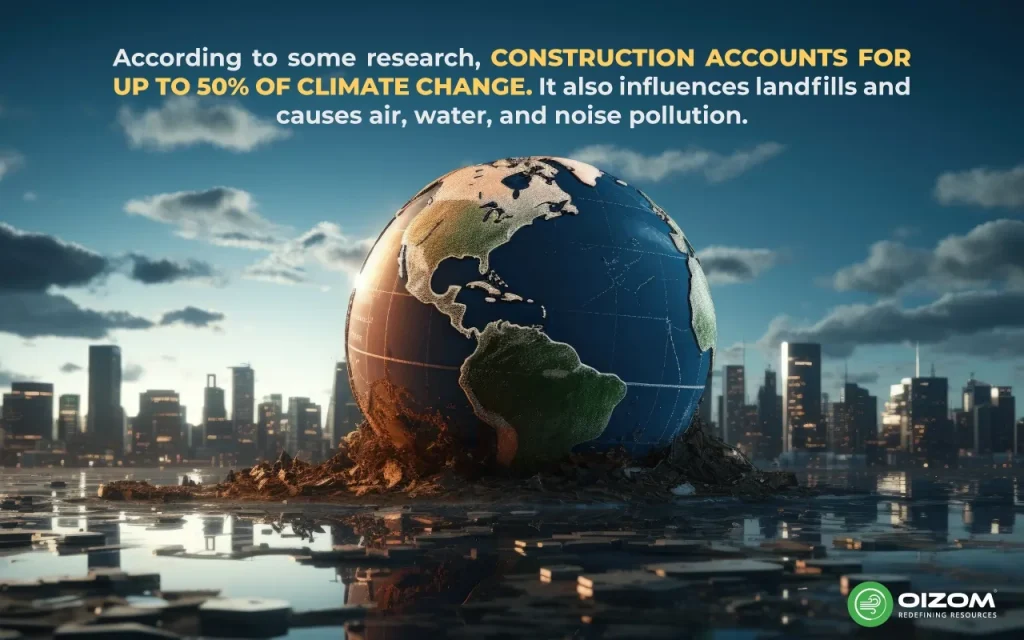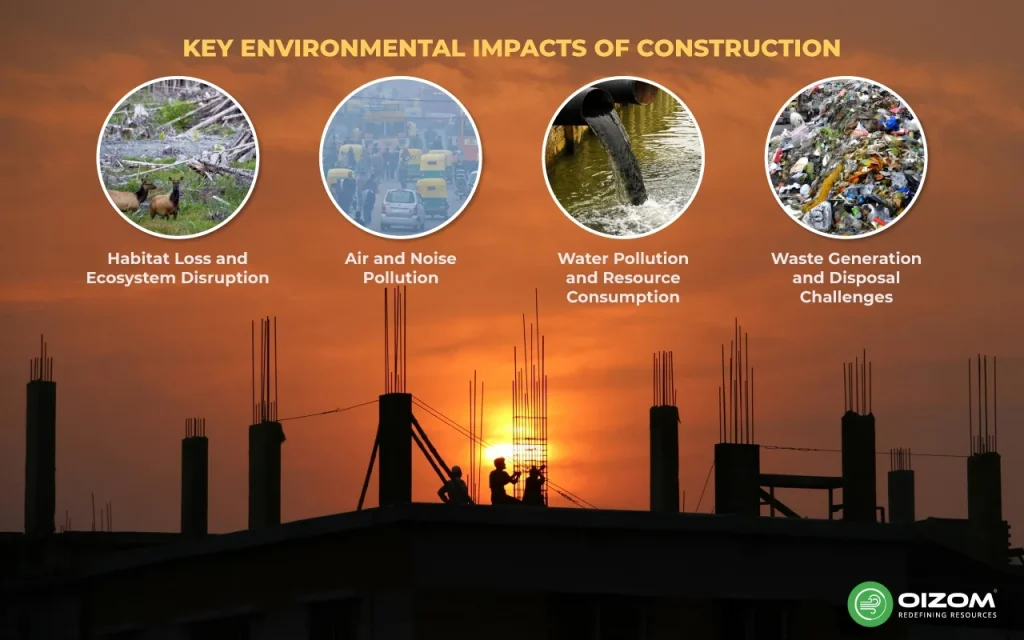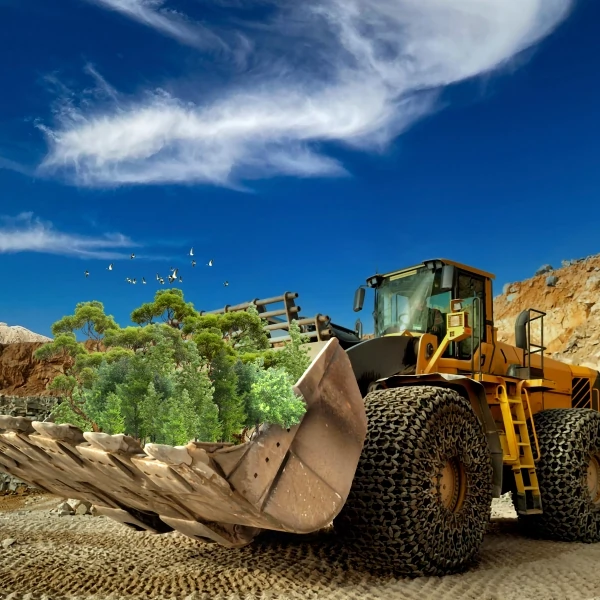Summary of Blog
The construction industry significantly impacts the environment, accounting for 23% of air pollution, 40% of drinking water contamination, and 50% of landfill waste. Key issues include habitat loss, ecosystem disruption, air and noise pollution, water pollution, and waste generation. Sustainable construction practices are essential to mitigate these impacts. Strategies include using eco-friendly building materials like recycled plastic and bamboo, implementing erosion and sediment controls, reducing waste through recycling, and obtaining green building certifications like IGBC and LEED. These practices lower carbon emissions, reduce operating costs, and improve indoor air quality. By prioritizing sustainable building, the industry can protect natural resources and promote healthier environments for future generations.
How Does Construction Affect The Environment
Have you ever heard the statement, ”Everyone acts as if nothing will change, yet everything changes”? It couldn’t be more true regarding building and its environmental approach. Some people pretend the climate isn’t changing and their companies have no environmental impact. However, many people are unaware of how construction pollution affects the environment. The construction sector accounts for 23% of air pollution, 40% of drinking water contamination, and 50% of landfill garbage.
Let me share one fact regarding the construction industry – Construction is a booming global industry. Between now and 2060, the world will likely construct almost 2.5 trillion square feet of new developments, equivalent to adding another Paris to the planet every week. If you’re wondering how to reduce the environmental impact of building, you are not alone. Here, I will help you to make your construction site eco-friendly. This article will explore the environmental impacts of construction, how to run a green construction company, and sustainable construction materials and processes.
Key Environmental Impacts of Construction

However, the industry is attempting to make beneficial adjustments to its working practices, materials, and manufacturing to reduce the negative consequences of building and protect the environment for future generations.

Habitat Loss and Ecosystem Disruption
- It may not seem surprising, but development significantly impacts natural ecosystems. Habitat loss manifests itself in various ways, and an area does not have to be entirely destroyed to experience long-term consequences. This involves habitat fragmentation and deterioration. Fragmentation refers to the division of animals by roads and developments. Destruction, fragmentation, and degradation all leave irreversible marks on the ground, making it critical to consider wildlife before starting a new project.
- Companies should apply wildlife-friendly measures when starting a new construction project, such as identifying vulnerable species, essential habitats, and the impact on migrating birds. While we generally consider land animals the most vulnerable to habitat loss, the built environment affects aquatic and bird species equally.
Air and Noise Pollution
- Regarding air pollution, every action counts, as producing dioxide gasses is one of the primary causes of global warming. The construction industry accounts for 39% of energy and process-related CO2 emissions. This high percentage results from construction-related activities, transportation, and building material manufacturing.
- Similarly, we should not overlook another significant source of air pollution: construction dust. PM10 is derived from cement, wood, or stone and is frequently invisible to the naked eye. When carried over great distances and for an extended period of time, this harmful construction dust can cause major health concerns in humans and animals.
- Construction has a negative impact on the environment because of noise pollution. There’s no way around it: construction equipment is noisy, and these noises may wreak havoc on the surrounding environment, particularly in a residential area. The various types of machinery used in excavation, demolition, construction, and landscaping contribute to noise pollution.
Water Pollution and Resource Consumption
- The damage extends below the surface when the ground is removed for a new building. If a body of water is on the site, rerouting or blocking the stream might significantly impact the surroundings. Sediment, or fine silt produced by loose soil, is a major issue in construction because it pollutes waterways and harms aquatic habitats. Sediment pollution can also have an impact on drinking water sources and fisheries, as well as contribute to future flooding.
- Typically, sediment is not the only material that ends up in the water. Construction sites produce a variety of things, including chemicals, oil, paint, and debris. Some types of pollution are easily repaired or will diminish with time, but construction pollution can harm groundwater, which is more difficult to remediate than surface water. Many populations rely on groundwater as their primary source, making protection essential.
Waste Generation and Disposal Challenges
- Construction projects also generate large volumes of garbage. A study found that US building and demolition operations generated 569 tons of debris. Much of it ends up in landfills across the country or goes to incinerators, which emit smoke and pollutants into the atmosphere as they operate. Both ways of disposal have a negative influence on the environment.
- Construction trash is one of the top contributors to industrial waste. Demolition projects account for nearly 90% of that amount, meaning most project materials are never reused.
How Construction Can Protect the Environment
The EPA’s standards are clear: Environmental preservation should come first in any construction project. This implies informing your contract workers that these regulations must be observed and that your company values environmental protection. Take a look at the Code of Regulations, many of which are complex but useful, and make sure you incorporate them into your daily chats, meetings, and general training procedures.
- Erosion and Sediment Controls – According to the laws, building companies must “design, install, and maintain” erosion controls to “minimize the discharge of pollutants.” These controls should include devices for reducing stormwater controls and lowering the “amount of soil exposed during construction activity.”
- Soil Stabilization is an important component of the construction process, and it must be “initiated immediately” whenever excavating work is carried out on a site. The rules indicate that the stabilization process must be “completed” within a time period applicable to local construction rules and regulations. However, the process may not be required depending on the structure of your construction project.
Strategies for Mitigating Construction's Environmental Impact

One of the biggest environmental issues with concrete construction sites is the large amount of carbon emissions created. To reduce these emissions and further minimize the environmental impacts of concrete construction sites, the following sustainable measures can be implemented:
Sustainable Site Planning and Design
Sustainable site planning is the process of designing a construction project while considering the environment. It considers site selection, landscaping, and stormwater management. Planning a site sustainably reduces the negative consequences of development on the surrounding area.
Utilizing Sustainable Building Materials
Sustainable construction materials are those that have a low environmental impact during their production. They also have a low environmental impact after construction is completed. Let’s consider some examples of sustainable construction materials, including the following:
- Renewable wood
- Recycled plastic
- Bamboo
- Recycled brick, concrete, and masonry
- Timbercrete
- Rammed earth
Construction Waste Reduction and Recycling
- Construction businesses can reduce their usage of new resources by purchasing used, salvaged, or recycled materials. They can also reduce waste by sending their construction and demolition materials to be recycled and reused in future projects.
- Appliances, fixtures, hardware, and materials such as brick, wood, metal, plastic, and concrete are all suitable for salvage or recycling. Metals and wood are highly recyclable, while materials such as bricks and concrete can be repurposed as fill or driveway bedding.
Green Building Certifications and Regulations
- Another option for construction companies to reduce their environmental impact is collaborating with land developers and architects to design and build greener buildings. One approach to accomplishing this is to design complexes that contain and protect natural space and buildings that use alternative energies such as solar panels or small wind turbines.
- Green buildings give numerous benefits, one of which is lower running expenses. Indian Green Building Council (IGBC) Green Rating for Integrated Habitat Assessment (GRIHA) is India’s most widely used green building certification program, and Leadership in Energy and Environmental Design (LEED) which is used in the US. This is US green building certification, which means certified buildings can save up to 20% on operating costs compared to traditionally designed structures. Green renovations and retrofits might result in savings of up to 10%. Green buildings also help improve employees’ health by reducing pollutants and increasing interior air quality.
Conclusion
Finally, Green infrastructure is an important and attractive response to our difficulties in a fast-changing world. Eco-friendly housing development has the potential to counteract climate change, protect our planet’s resources, and provide healthier, more sustainably built habitats for future generations. However, major issues are faced during the construction, such as dust emissions, noise pollution, and other VOCs emitted during the phase. Implementing effective dust control measures in construction becomes essential, and tools like Dustroid help by accurately monitoring various PM levels in real time through a cloud-based platform.
By incorporating sustainable building practices, such as innovative design principles, utilizing sustainable materials, waste reduction, and green building certifications, we can revolutionize how we construct and inhabit our buildings, conserve natural resources, and contribute to the overall well-being of humans and the environment.






